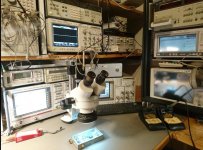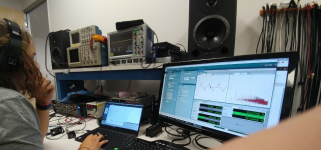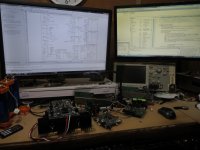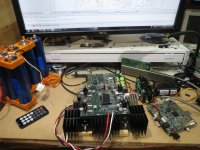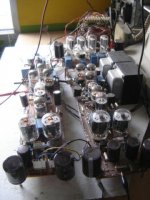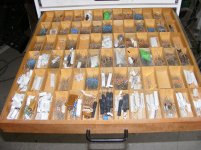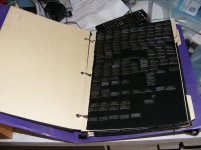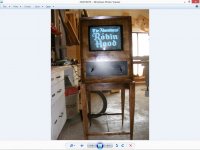Finally, I got rid of something of my workbench. It has bugged me since a long time. The foot of the microscope. It was never big enough when I put medium size cards on it or always too close when I turned the foot away and tried to work on the table.
Now the microscope hangs from the 1st floor of the table. I can move it easily left/right. The mounting beam is 2 square aluminium tubes with one fitting into the other just so. The beam can be telescoped to pull it near or shove it away.
The bench is constructed from 4 sheets of Ikea Pronomen wood, 60*200 cm. The table itself is thus 120 cm deep.
Now the microscope hangs from the 1st floor of the table. I can move it easily left/right. The mounting beam is 2 square aluminium tubes with one fitting into the other just so. The beam can be telescoped to pull it near or shove it away.
The bench is constructed from 4 sheets of Ikea Pronomen wood, 60*200 cm. The table itself is thus 120 cm deep.
Attachments
Too much stuff and all in the way!
Hello,
Someone please post a commercial lab's test bench photo. Where is the test gear stored?
I am finding that if I put everything I own on the wall above the bench the test leads are not long enough or if it is kept on the bench there is no space to work.
I bought a nice new hospital crash cart surplus from UC Davis and roll the test gear; o'scope, power supplies, network analyzer, audio analyzer and what ever test equipment up to the bench that is needed.
DT
Hello,
Someone please post a commercial lab's test bench photo. Where is the test gear stored?
I am finding that if I put everything I own on the wall above the bench the test leads are not long enough or if it is kept on the bench there is no space to work.
I bought a nice new hospital crash cart surplus from UC Davis and roll the test gear; o'scope, power supplies, network analyzer, audio analyzer and what ever test equipment up to the bench that is needed.
DT
For work, we always have shelving where test equipment is stored, and you only put what you need for a given task on your desk. For some things (generally involving dewars) you take the thing to be tested to a dedicated test station.
Test gear towers are generally frowned upon, both because they're showing that the person building them has no idea what's wrong with their kit, and because they're depriving everyone else in the lab of the use of the gear that's in their stack.
Test gear towers are generally frowned upon, both because they're showing that the person building them has no idea what's wrong with their kit, and because they're depriving everyone else in the lab of the use of the gear that's in their stack.
This is the test bench at the San Jose office of a major chip vendor. Its an assortment of instruments, all relevant to troubleshooting audio stuff. The main instrument is a latest version APx555 but the LeCroy scope is also very useful.
If you are wondering the AP is displaying the waveform and spectrum of noise picked up from an unconnected input cable. Nothing much to see. . .
If you are wondering the AP is displaying the waveform and spectrum of noise picked up from an unconnected input cable. Nothing much to see. . .
Attachments
Demian,
3 scopes but I see only a solitary scope probe. Somebody is hoarding the rest of the probes? I find probes are always a hot commodity in a lab.
One probe was all that was needed to see if clocks were present. I'm sure there are more somewhere.
Good probes that work with what you are doing are priceless. I have an assortment of Tek and HP probes. The HP probes are really small and good for small stuff. The newer cheapie probes just don't work well for me.
Hi gerhard,
That's an awesome bench! Way to go!
What do you work on mostly?
Hi Suzy,
For some of us, the work is too varied and the surrounding space too limited to store everything that we need at the moment or for the one job. That's the case with me. I often end up doing some unplanned for operation on a repair. Struck by technician is most of what I get. That and the gear I put on the bench is old and very heavy. Not moving that around any time soon. So the only answer is to put most of my most used test gear on the bench on shelves. In my case, modeled after the 19" rack.
I just bought a DC current probe to look after times when I need an HP 428B. Those take up a lot of space on the bench. They don't stack. However, there are times when I need their most sensitive range. I think it's more accurate than the 34134A probes. I need to get something similar for an oscilloscope probe, hopefully this year.
I switch between design work and repairs often as well. As you know, the design phase often only needs basic instruments. But, having a spec-an ready can be invaluable. Wish I could afford modern test equipment, but this stuff still allows me to do what I have to do. Modulation envelopes would really benefit from a new spectrum or network analyzer.
Hi Demian,
Yes, probes are worth their weight in gold - more even. I use cheap probes for non-critical work and bring out th ereal probes only when the measurement must be very accurate, or high frequencies are involved. I'm trying to extend the life of my HP and Tek probes.
-Chris
That's an awesome bench! Way to go!
What do you work on mostly?
Hi Suzy,
For some of us, the work is too varied and the surrounding space too limited to store everything that we need at the moment or for the one job. That's the case with me. I often end up doing some unplanned for operation on a repair. Struck by technician is most of what I get. That and the gear I put on the bench is old and very heavy. Not moving that around any time soon. So the only answer is to put most of my most used test gear on the bench on shelves. In my case, modeled after the 19" rack.
I just bought a DC current probe to look after times when I need an HP 428B. Those take up a lot of space on the bench. They don't stack. However, there are times when I need their most sensitive range. I think it's more accurate than the 34134A probes. I need to get something similar for an oscilloscope probe, hopefully this year.
I switch between design work and repairs often as well. As you know, the design phase often only needs basic instruments. But, having a spec-an ready can be invaluable. Wish I could afford modern test equipment, but this stuff still allows me to do what I have to do. Modulation envelopes would really benefit from a new spectrum or network analyzer.
Hi Demian,
Yes, probes are worth their weight in gold - more even. I use cheap probes for non-critical work and bring out th ereal probes only when the measurement must be very accurate, or high frequencies are involved. I'm trying to extend the life of my HP and Tek probes.
-Chris
Good probes that work with what you are doing are priceless. I have an assortment of Tek and HP probes. The HP probes are really small and good for small stuff. The newer cheapie probes just don't work well for me.
you can say that over and over again. (sometimes you'll see a TEK scope with probes -- probes worth more than the scope!)
i've thrown out all the non-Pomona patch cords.
used to be awash in old tek probes around here, always available. Now... we have lost almost all of our surplus outlets and no place to find the flotsam! My bins are loaded with old tek cast off parts, no new ones though. all gone to ebay instead of surplus or the country store.
Cheers
Alan
Cheers
Alan
My workbench has several drawers made to sort and hold parts. Then forothe stuff I use notebooks with pages covered in conductive foam.
Finally a small project, a black and white TV that automatically shows old programs from the black and white TV show years.
Finally a small project, a black and white TV that automatically shows old programs from the black and white TV show years.
Attachments
Slightly disappointed - I was expecting the TV controls to be labeled 'decade' & 'year' like a time machine!
Not a bad idea, easy to do as it is really an old obsolete PC inside. Year OK, decade a bit harder. First Tv broadcast in the US was 191, color in 1951! By 1968 even Mr Rogers went to color TV. I actually have parts from the Ampex converted to color video recorder they used!
Hard part was turning DVDs into useful data files. It holds several hundred hours of TV
The other version of the notebook pages just use strips of foam and transistors are inserted into the side. I have 4 notebooks, transistors, linear, Cmos and digital/memory.
Last edited:
I use notebooks with pages covered in conductive foam.......That notebook is a great idea for logic chips!
I made notebooks like that back in the 70's through the 90's. Some now rare and priceless electronic music chips from SSM, CEM and Mostek were destroyed after 25 to 45 years in the foam (two notebook pages full). So were a few hundred CMOS and TTL chips, but you can still buy them.
After 10 years or so the foam starts to crumble. As it does it eats the tin coating off the pins on the DIP chips, then the pins turn to dust. I have several priceless music synthesizer chips from the 70's and 80's that have little stubs sticking out their sides. I have managed to save some by soldering them onto machined pin sockets, then plugging the socket into the socket on the synth board. They have zero resale value, but I have collected them over the years for the synthesizer that I am now building.
The chip notebooks were stored in a closet inside an air conditioned house in Florida for a long time. The room was illuminated with two 4 foot fluorescent shop lights which do emit a fair amount of UV light. Whether this contributed to their demise or not, I don't know. Several chips stored in the little foam sample packs that Signetics used to give out were also damaged. Even the SMD chips were trashed, but those in the pink poly bags were OK.
Check your chips NOW before it's too late if you have had them in foam for a long time.
- Home
- Design & Build
- Equipment & Tools
- What's on your workbench???
